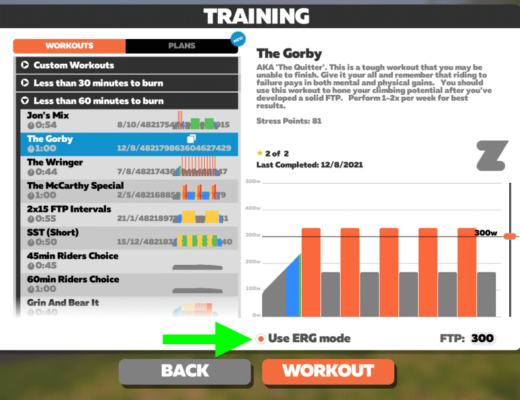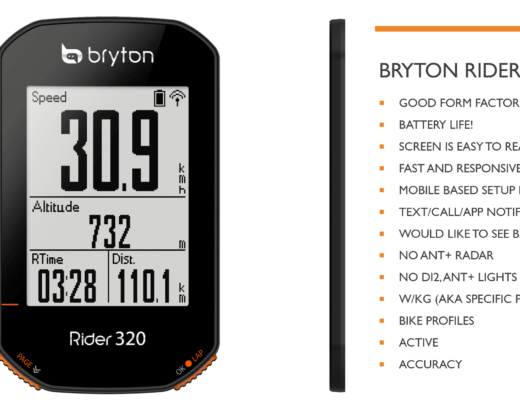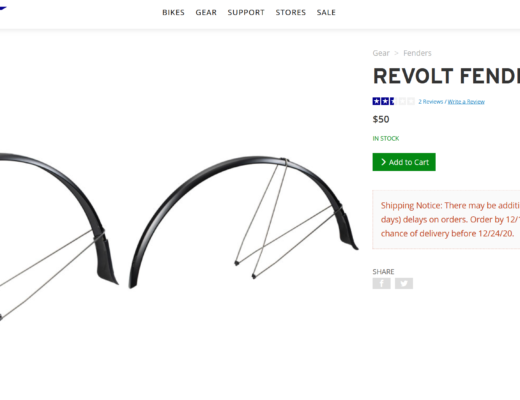A friend recently asked me to assist them with putting together a training plan. They didn’t provide much in the way of specific goals, so I shared some thoughts on how I approach training. What I’m currently doing, which includes work on the bike as well as off. Some of the way, or maybe why, I do the off-bike work is structured for cycling fitness, but even before I started cycling I was doing those things to address issues with my back and pelvic stability. I think it’s too easy to get hyper-focused on cycling fitness and forget that it’s not great to just train one region of the body. It’s not good to ignore the other bits; I was guilty of this for many years, and that could play a role in why I have back and pelvic stability issues :). So here goes…
First off, I need to say out loud that I’m not qualified to be a coach. So massive caveats to everything I’m going to say. But having said that, I have seen huge improvement since I started looking at the bike as a fitness tool (~3.5 years ago) using the plan below; which has adapted slightly over time.
How much time do you have per-day/week to train? I’ve laid out my current plan below, but it will be important to adapt that while aligning the principles to your schedule, and keeping in mind that if you’re not already putting in significant time on the bike, you will want to ease into it. Going from a couple hours straight to 10-15 hours wouldn’t be good for you.
Do you have a smart trainer? I find this to be the most useful tool for structured training because it’s difficult to do structure outside where we live, but if you’d rather train outside I would prioritize a PM on the bike over wheels, or most anything else because it’s the thing that will make it possible to get stronger, the other things will just make you ride faster. Not that they aren’t good, just less good IMO.
I don’t know exactly where your fitness is at, so going to start at the most basic level. Feel free to skip this part if you just want the plan. It’s my understanding that we want to build a fitness pyramid that looks something like this.
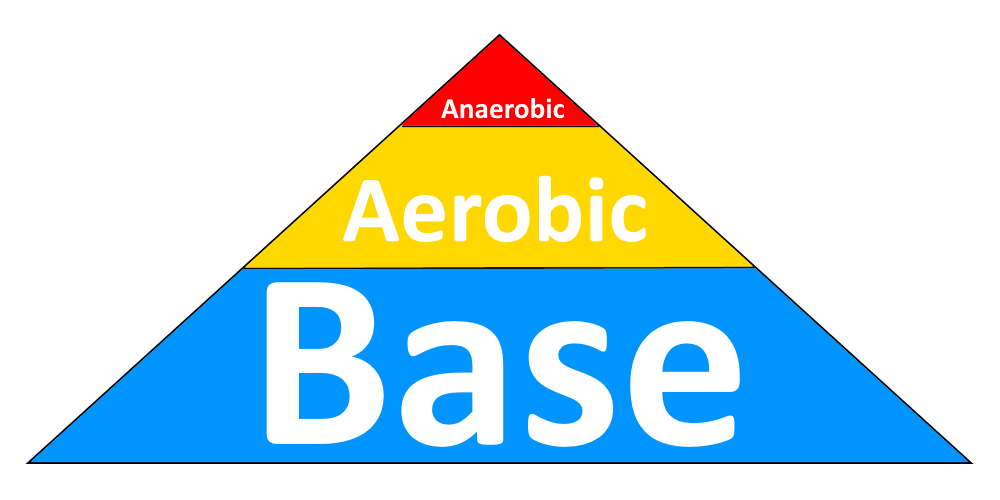
This is not drawn to scale; I just made it up using my limited drawing skills :). But it’s helpful to understand how you want to divide up the work. This is one area where having a Garmin is a huge help, because it counts up the buckets for you. The general categories are Base (which is also called Zone 2 (Z2) or Endurance), Aerobic (divided into Tempo – Z3 and Threshold – Z4), and Anaerobic (VO2 Max – Z5, Anaerobic – Z6; I know this is weirdly named, but I didn’t make it up), and Neuromuscular (Z7). Like in the chart below, which I pulled from a recent workout.
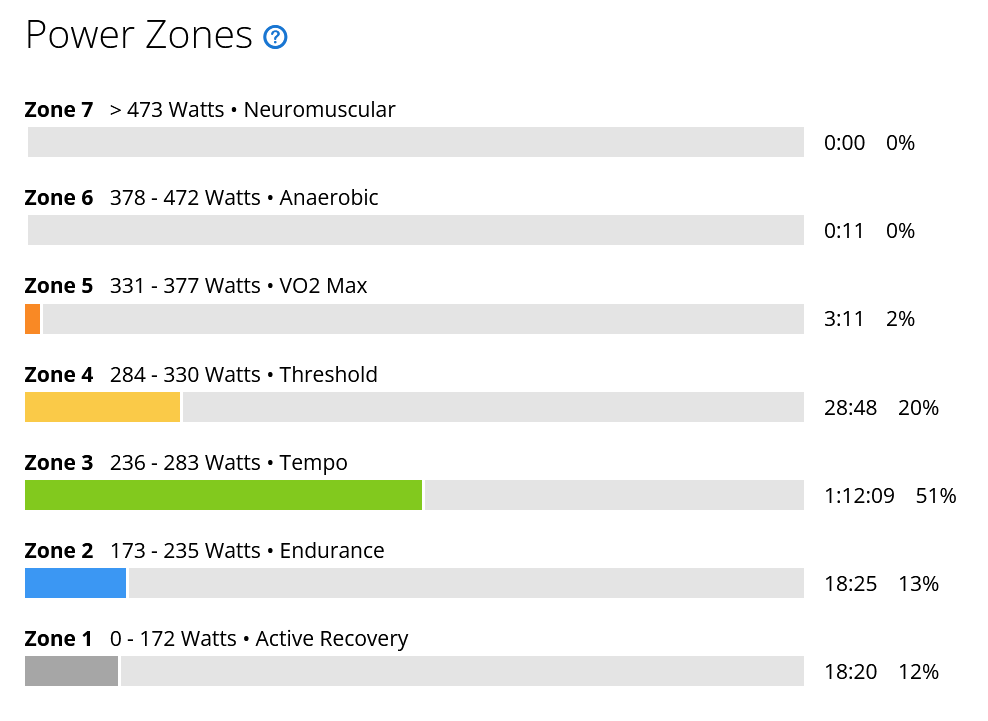
The pyramid model captures not only the volume of each, but that you will have a hard time building a strong Aerobic engine if your Base volume is too low (think rectangle shaped). Most training plans start with a huge influx of Base, and then as that solid foundation is built, you scale up the other parts consistent with the desired volume to hit your fitness targets.
With all that theory out of the way, this is what I do. This has changed somewhat since I started using Xert. They have me doing way more of the mixed Base/Tempo LSD (long slow distance) rides than I was doing before. It’s been great for me. Fixing significant gaps in my fitness, and I suspect that the problem was that my pyramid looked more like this when I was totally doing my own thing:
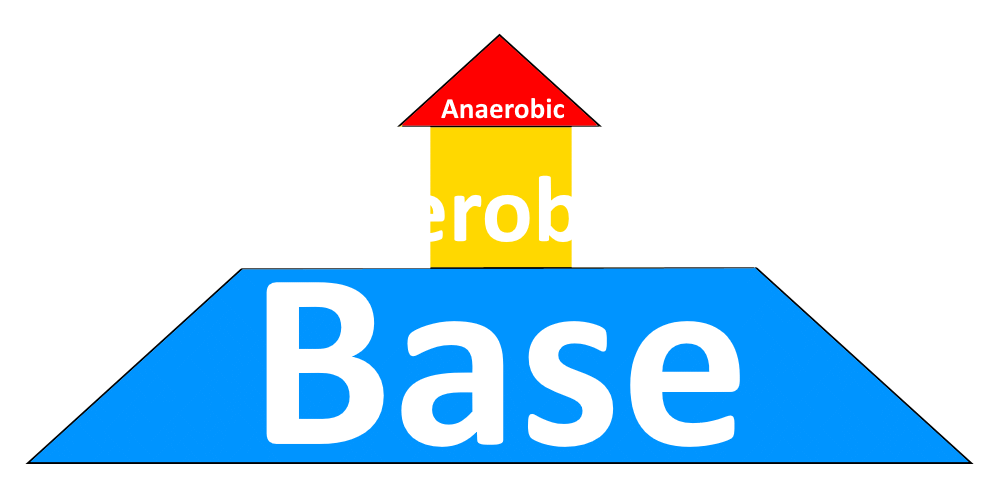
I’ve linked some of my Strava activities which have zone data in the images to help visualize what the structure looks like for the workouts mentioned below. If you’re using Zwift, it’s fairly easy to create the ZWO files. Probably also true for other training platforms.
- Sat: Base focus (summer), LSD 3-5 hours, unstructured. High Aerobic focus with a little base (winter), 2-3 hours, structured.
- Sun: Base focus (summer), LSD 3-5 hours, unstructured. High Aerobic focus with a little base (winter), 2-3 hours, structured.
- Mon: Recovery/base 45-60 min, structured. HEAVY deadlifting, low reps (3-5 per set, 3-5 sets). If I had a squat rack, I would do squats too, but deadlifts are more important. Interleave pullups during leg set “recovery”.
- Tue: Threshold/VO2Max focus, Ronnestad, Gorby, something else that hurts a lot. 60-90 min, structured. Depending on how the legs feel from Mon, I may swap Tue for Thu. If the legs are too tired, it’s better to punt to Thu.
- Wed: Recovery/base focus: 45-60 min, structured. Body weight for arms, chest, back, and core: https://youtu.be/sYYjx_W7rUY
- Thu: Tempo (trading with Tue if necessary) focus: 60-90 min, structured or unstructured. This can be SST, but I prefer the Tempo LSD. Where instead of base/tempo flip, I get a tempo/threshold flip. This will build your endurance and strength very quickly. BUT MAKE SURE YOU HAVE THE BASE COVERED before going crazy here.
- Fri: Recovery/base 45-60 min, structured or unstructured. HEAVY deadlifting, low reps (3-5 per set, 3-5 sets). If I had a squat rack, I would do squats too, but deadlifts are more important. Interleave pullups during leg set “recovery”.
IMO, it is critical to pay attention to your biometric data. If you don’t have a way to monitor this data like resting heartrate (RHR), heartrate variability (HRV), sleep recovery, etc. off the bike I would strongly recommend that you get something that will provide that data. There are tons of options, as long as it has a solid HR sensor and does the data, it should be fine. I use a Garmin fēnix 6 for this.
I cannot stress how important it is IMO, to pay attention to your bio data. If your RHR is 5-10 BPM over what it should be, take a easy day. Either totally off the bike, or by swapping a recovery/base day for a HIT day. Your heart, and to a lessor extent, recovery metrics are like the temp/oil pressure gauges on a car, super important to pay attention to that stuff or the engine will blow up.
The final bit is some way to track training load. Progressive overload is the key to getting stronger (i.e. doing more until you get a new fitness signature, then doing that at a higher intensity – rinse, lather, repeat). TSS/XSS tell you what that load is, so you can do more in the next block. Your TSS/XSS is relative though, so very much a function of your power zones (have you done a FTP test?). TL for a workout done at X power when your FTP was Y, will be lower when done at X power when the FTP is > Y. This is an important concept so you don’t de-train.
If you have a Garmin, it will track load. Otherwise, you can either use a free TrainingPeaks account or pay Xert $10/mon (what I do) to track your TL; the benefit to Xert is that they suggest workouts and make up the TL targets so you don’t have to. If you decide to use Xert, we should have a conversation about that specifically. While I have realized significant value from using the platform, it is far from perfect. There are rough edges everywhere, some of which are potentially harmful.
Lastly, it’s hard to do too much base, so when in doubt cover your base.
